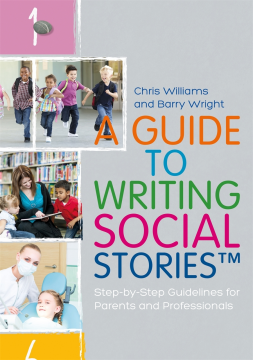
Additional Information
Book Details
Abstract
Social Stories™ are a widely used and highly effective intervention for supporting children on the autism spectrum, but it can feel overwhelming to follow all the rules put in place to create personalised stories. Developed with the input of parents and professionals, and informed by new Social Stories research, this is a comprehensive, clear, easy step-by-step guide to writing effective personalised Social Stories™ that give children social information, creating many benefits for them.
The book includes many examples of real Social Stories created for children by parents and teachers working together, and handy downloadable checklists that highlight the essential components of a Social Story, helping to ensure that each story you write achieves the best possible results.
Thank heavens for Social Stories™. I have used them often to explain life on planet Earth when my son is convinced that he is the only Martian present and that humans are weird. This brilliant book is so encouraging - a great reminder of why it is worth taking time and effort to write good stories and avoid the pitfalls.
Rowena Harper, parent
Williams and Wright's book argues that Social Stories™ are a powerful method for making life easier for kids with autism or Asperger Syndrome, to reduce the confusion that arises from 'mindblindness' and a piecemeal perception of the world. Social Stories™ provide clear explanations for social conventions in a rule-based way, thereby 'systemizing' the social world, to render it less confusing. Social Stories™ need scientific evaluation in a randomised control trial, but this book will help teachers learn how to implement this imaginative method.
Professor Simon Baron-Cohen, Autism Research Centre, Cambridge University
Chris Williams is a Clinical Psychologist and Barry Wright is a Consultant Child and Adolescent Psychiatrist. They have both worked for the NHS with children with ASDs and their families for over 20 years. They are the authors of How to Live with Autism and Asperger Syndrome: Practical Strategies for Parents and Professionals and Intervention and Support for Parents and Carers of Children and Young People on the Autism Spectrum: A Resource for Trainers, both published by JKP. They both live in North Yorkshire, UK.
I think this will be a helpful book for anyone who is living or working with a child who has an autistic spectrum disorder. Social Stories™ are very useful but it can be quite a challenge to write your own. This book is designed to get you started. The authors provide straightforward guidelines and lots of practical examples of Social Stories™ written for particular children. They annotate these stories so that readers can see how the process works. As a professional who regularly sees parents of children with a diagnosis of ASD, I will be adding this book to my list of valued references.
Jo McMahon, Consultant Clinical Psychologist
Finally, a book that combines a practical step-by-step guide on creating and using Social Stories™ with real-life examples and a collection of sample Stories. This wonderful volume presents a user-friendly approach to writing Social Stories™, and is written with humor in easy-to-understand language. It is bound to become your new "go to" Social Stories™ manual.
Anastasia Kokina, Ph.D., Assistant Professor, Department of Instruction and Learning, University of Pittsburgh, USA
Table of Contents
| Section Title | Page | Action | Price |
|---|---|---|---|
| A Guide to Writing Social Stories: Step-by-Step Guidelines for Parents and Professionals by Chris Williams and Barry Wright | 3 | ||
| Foreword: A Parent’s View | 7 | ||
| Acknowledgements | 9 | ||
| Introduction | 11 | ||
| Part 1 - Social Stories\n and Autism | 13 | ||
| 1. Understanding Autism | 15 | ||
| 2. What is a Social Story? | 27 | ||
| Part 2 - A Guide to Writing \nSocial Stories\n for Teachers and Parents | 33 | ||
| 3. A Guide to Social Stories | 35 | ||
| Part 3 - Gathering Information and\nSocial Stories: \nWorked Examples | 59 | ||
| 4. Gathering Information | 61 | ||
| Why do we fart? | 68 | ||
| Time to think | 73 | ||
| What happens when i have a seizure? (Thomas’s Story) | 79 | ||
| More Examples of Social Stories | 83 | ||
| Why we go to school | 85 | ||
| Working on my own | 88 | ||
| Focusing and concentrating | 90 | ||
| Trying hard at swimming | 92 | ||
| Joining school swimming lessons | 95 | ||
| Happy playtimes | 97 | ||
| Taking new medicine | 100 | ||
| Finding out about Archbishop Holgate Sixth Form | 102 | ||
| Visiting the dentist | 104 | ||
| Why we do homework | 106 | ||
| How to take tests | 108 | ||
| Waiting to ask the teacher a question | 110 | ||
| Going to Flamingo Land | 112 | ||
| I am a kind, intelligent person | 114 | ||
| Using words that people like | 118 | ||
| Appendices | 121 | ||
| A Template for Making Sense of a Child’s Behaviour and Planning Ways to Help | 123 | ||
| Step-by-Step Flowchart | 126 | ||
| Checklist | 128 | ||
| Checklist (short version) | 133 | ||
| Definitions of Terms | 136 | ||
| References | 138 | ||
| Index | 139 |
